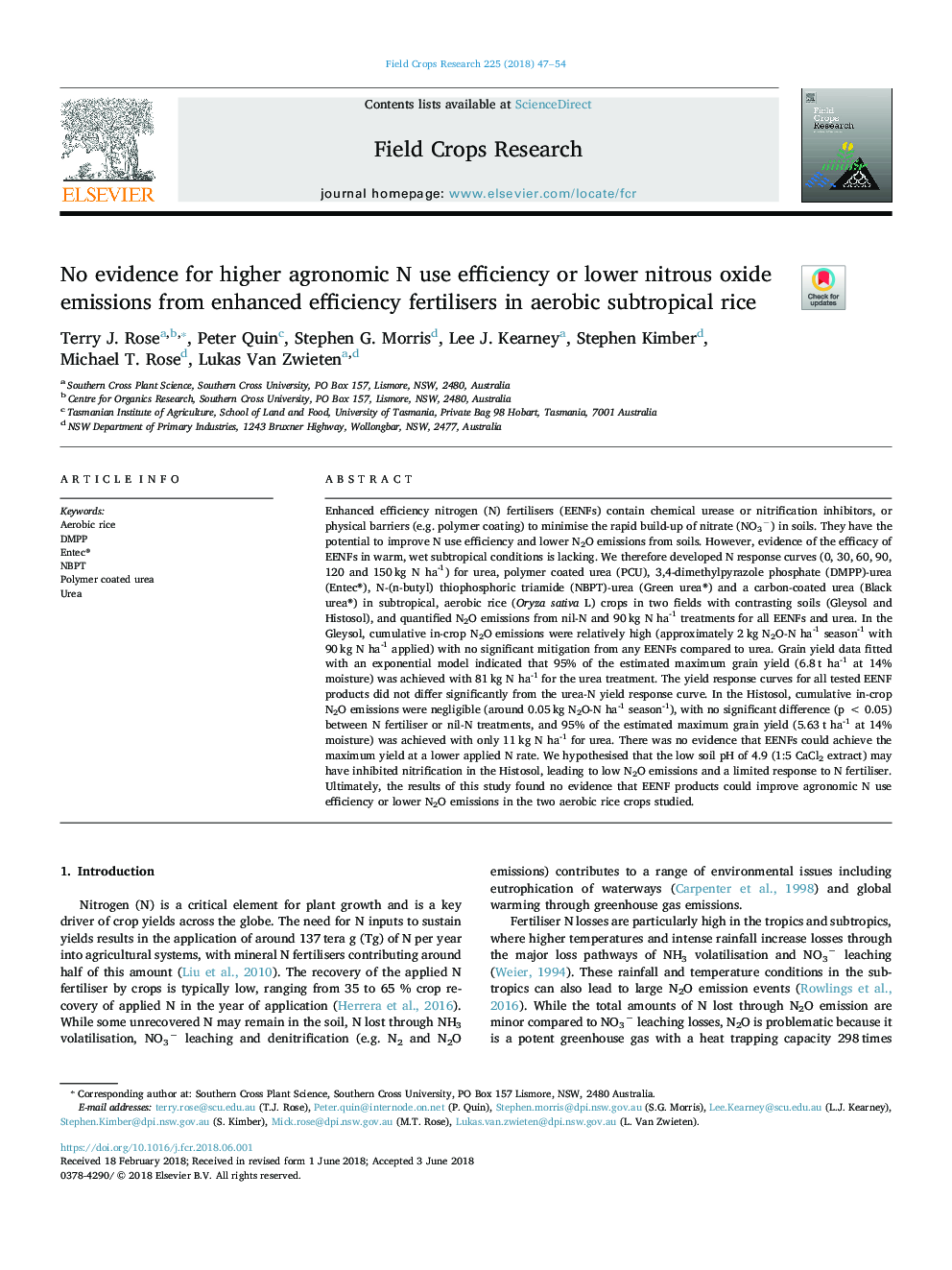| کد مقاله | کد نشریه | سال انتشار | مقاله انگلیسی | نسخه تمام متن |
|---|---|---|---|---|
| 8879082 | 1624638 | 2018 | 8 صفحه PDF | دانلود رایگان |
عنوان انگلیسی مقاله ISI
No evidence for higher agronomic N use efficiency or lower nitrous oxide emissions from enhanced efficiency fertilisers in aerobic subtropical rice
دانلود مقاله + سفارش ترجمه
دانلود مقاله ISI انگلیسی
رایگان برای ایرانیان
کلمات کلیدی
موضوعات مرتبط
علوم زیستی و بیوفناوری
علوم کشاورزی و بیولوژیک
علوم زراعت و اصلاح نباتات
پیش نمایش صفحه اول مقاله

چکیده انگلیسی
Enhanced efficiency nitrogen (N) fertilisers (EENFs) contain chemical urease or nitrification inhibitors, or physical barriers (e.g. polymer coating) to minimise the rapid build-up of nitrate (NO3â) in soils. They have the potential to improve N use efficiency and lower N2O emissions from soils. However, evidence of the efficacy of EENFs in warm, wet subtropical conditions is lacking. We therefore developed N response curves (0, 30, 60, 90, 120 and 150â¯kg N ha-1) for urea, polymer coated urea (PCU), 3,4-dimethylpyrazole phosphate (DMPP)-urea (Entec®), N-(n-butyl) thiophosphoric triamide (NBPT)-urea (Green urea®) and a carbon-coated urea (Black urea®) in subtropical, aerobic rice (Oryza sativa L) crops in two fields with contrasting soils (Gleysol and Histosol), and quantified N2O emissions from nil-N and 90â¯kg N ha-1 treatments for all EENFs and urea. In the Gleysol, cumulative in-crop N2O emissions were relatively high (approximately 2â¯kg N2O-N ha-1 season-1 with 90â¯kg N ha-1 applied) with no significant mitigation from any EENFs compared to urea. Grain yield data fitted with an exponential model indicated that 95% of the estimated maximum grain yield (6.8â¯t ha-1 at 14% moisture) was achieved with 81â¯kg N ha-1 for the urea treatment. The yield response curves for all tested EENF products did not differ significantly from the urea-N yield response curve. In the Histosol, cumulative in-crop N2O emissions were negligible (around 0.05â¯kg N2O-N ha-1 season-1), with no significant difference (pâ¯<â¯0.05) between N fertiliser or nil-N treatments, and 95% of the estimated maximum grain yield (5.63â¯t ha-1 at 14% moisture) was achieved with only 11â¯kg N ha-1 for urea. There was no evidence that EENFs could achieve the maximum yield at a lower applied N rate. We hypothesised that the low soil pH of 4.9 (1:5 CaCl2 extract) may have inhibited nitrification in the Histosol, leading to low N2O emissions and a limited response to N fertiliser. Ultimately, the results of this study found no evidence that EENF products could improve agronomic N use efficiency or lower N2O emissions in the two aerobic rice crops studied.
ناشر
Database: Elsevier - ScienceDirect (ساینس دایرکت)
Journal: Field Crops Research - Volume 225, 1 August 2018, Pages 47-54
Journal: Field Crops Research - Volume 225, 1 August 2018, Pages 47-54
نویسندگان
Terry J. Rose, Peter Quin, Stephen G. Morris, Lee J. Kearney, Stephen Kimber, Michael T. Rose, Lukas Van Zwieten,